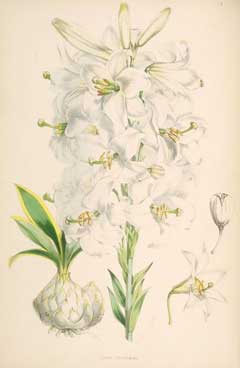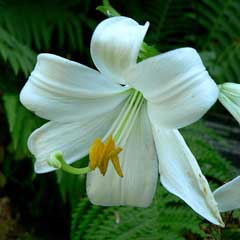 |
|
http://commons.wikimedia.org/wiki/File:Lilium_candidum.jpg |
 |
| http://commons.wikimedia.org/wiki/User:Stan_Shebs |
Translate this page:
Summary
Physical Characteristics

 Lilium candidum is a BULB growing to 1 m (3ft 3in) by 0.3 m (1ft).
Lilium candidum is a BULB growing to 1 m (3ft 3in) by 0.3 m (1ft).
See above for USDA hardiness. It is hardy to UK zone 6. It is in leaf from October to July, in flower in July, and the seeds ripen from August to September. The species is hermaphrodite (has both male and female organs) and is pollinated by Bees.
Suitable for: light (sandy), medium (loamy) and heavy (clay) soils and prefers well-drained soil. Suitable pH: mildly acid, neutral and basic (mildly alkaline) soils. It can grow in semi-shade (light woodland) or no shade. It prefers moist soil.
UK Hardiness Map
US Hardiness Map
Synonyms
Plant Habitats
Woodland Garden Sunny Edge; Dappled Shade;
Edible Uses
Edible Parts: Root
Edible Uses:
Bulb - cooked. The raw bulb contains an acrid principle, but this is destroyed by drying or thorough heating[4]. When cooked the bulb is pulpy, sweet and sugary[4]. Rich in starch, it can be used as a vegetable in similar ways to potatoes (Solanum tuberosum).
References More on Edible Uses
Medicinal Uses
Plants For A Future can not take any responsibility for any adverse effects from the use of plants. Always seek advice from a professional before using a plant medicinally.
Astringent Demulcent Emmenagogue Emollient Epilepsy Expectorant
The Madonna lily has a long history of herbal use, though it is seldom employed in modern herbalism because of its scarcity[238]. The bulb and the flowers are astringent, highly demulcent, emmenagogue, emollient and expectorant[4, 7, 238]. The plant is mainly used externally, being applied as a poultice to tumours, ulcers, external inflammations etc[4, 238]. The bulb is harvested in August and can be used fresh or dried[4, 238]. The flowers are harvested when fully open and used fresh for making juice, ointments or tinctures[238]. The pollen has been used in the treatment of epilepsy[240].
References More on Medicinal Uses
The Bookshop: Edible Plant Books
Our Latest books on Perennial Plants For Food Forests and Permaculture Gardens in paperback or digital formats.

Edible Tropical Plants
Food Forest Plants for Hotter Conditions: 250+ Plants For Tropical Food Forests & Permaculture Gardens.
More

Edible Temperate Plants
Plants for Your Food Forest: 500 Plants for Temperate Food Forests & Permaculture Gardens.
More

More Books
PFAF have eight books available in paperback and digital formats. Browse the shop for more information.
Shop Now
Other Uses
References More on Other Uses
Cultivation details
Prefers an open free-draining humus-rich fertile loamy soil with its roots in the shade and its head in the sun[90, 200]. Prefers a sunny position[143] but also succeeds in shade[163]. Succeeds in ordinary garden soil[1]. Grows well in acid[42] and limy soils[4, 42, 47, 90], though it prefers a limey soil[200]. A very ornamental plant[1, 7]. It is seen as a symbol of purity and in Christian tradition is devoted to the Virgin Mary, in pre-Christian times it was sacred to Juno, the Goddess of heaven[238]. The flowers have a scent of heather honey[245]. The Madonna lily is generally very hardy and easy to grow[143] but it is unpredictable and does not grow or flower well in all gardens[90, 238]. It is also susceptible to botrytis[143]. Only just cover the bulb with soil[47, 200]. It is best to leave the clumps undisturbed since they resent being moved[143, 238], but if you need to transplant then this is best done in late August to early September, certainly no later than mid-October[143]. Plants produce a basal rosette of over-wintering leaves in the autumn[200], these die off as the plant comes into flower[188]. The plant should be protected against rabbits and slugs in early spring. If the shoot tip is eaten out the bulb will not grow in that year and will lose vigour[200].
References Carbon Farming Information and Carbon Sequestration Information
Temperature Converter
Type a value in the Celsius field to convert the value to Fahrenheit:
Fahrenheit:
The PFAF Bookshop
Plants For A Future have a number of books available in paperback and digital form. Book titles include Edible Plants, Edible Perennials, Edible Trees,Edible Shrubs, Woodland Gardening, and Temperate Food Forest Plants. Our new book is Food Forest Plants For Hotter Conditions (Tropical and Sub-Tropical).
Shop Now
Plant Propagation
Seed - immediate epigeal germination[130]. Sow thinly in pots from late winter to early spring in a cold frame. Should germinate in 2 - 4 weeks[163]. Great care should be taken in pricking out the young seedlings, many people prefer to leave them in the seed pot until they die down at the end of their second years growth. This necessitates sowing the seed thinly and using a reasonably fertile sowing medium. The plants will also require regular feeding when in growth. Divide the young bulbs when they are dormant, putting 2 - 3 in each pot, and grow them on for at least another year before planting them out into their permanent positions when the plants are dormant[K]. Division with care in the autumn once the leaves have died down. Replant immediately[200]. Bulb scales can be removed from the bulbs in early autumn. If they are kept in a warm dark place in a bag of moist peat, they will produce bulblets. These bulblets can be potted up and grown on in the greenhouse until they are large enough to plant out[200]. Bulblets are formed on the stem just below the soil surface. These should be dug up in the autumn and replanted immediately, preferably in a cold frame for growing on until large enough to plant out into the garden[143, 163]. The formation of bulbils on the stem can be induced by either removing the stem at flowering time and layering it just below the soil surface, or by removing all the flowers before they open.
Other Names
If available other names are mentioned here
Native Range
TEMPERATE ASIA: Israel, Lebanon, Syria, Turkey (southwest) EUROPE: Former Yugoslavia (south), Greece (w. & s.)
Weed Potential
Right plant wrong place. We are currently updating this section.
Please note that a plant may be invasive in one area but may not in your area so it's worth checking.
Conservation Status
IUCN Red List of Threatened Plants Status :

Growth: S = slow M = medium F = fast. Soil: L = light (sandy) M = medium H = heavy (clay). pH: A = acid N = neutral B = basic (alkaline). Shade: F = full shade S = semi-shade N = no shade. Moisture: D = dry M = Moist We = wet Wa = water.
Now available:
Food Forest Plants for Mediterranean Conditions
350+ Perennial Plants For Mediterranean and Drier Food Forests and Permaculture Gardens.
[Paperback and eBook]
This is the third in Plants For A Future's series of plant guides for food forests tailored to
specific climate zones. Following volumes on temperate and tropical ecosystems, this book focuses
on species suited to Mediterranean conditions—regions with hot, dry summers and cool, wet winters,
often facing the added challenge of climate change.
Read More
Expert comment
Author
L.
Botanical References
50200
Links / References
For a list of references used on this page please go here
Readers comment
© 2010, Plants For A Future. Plants For A Future is a charitable company limited by guarantee, registered in England and Wales. Charity No. 1057719, Company No. 3204567.